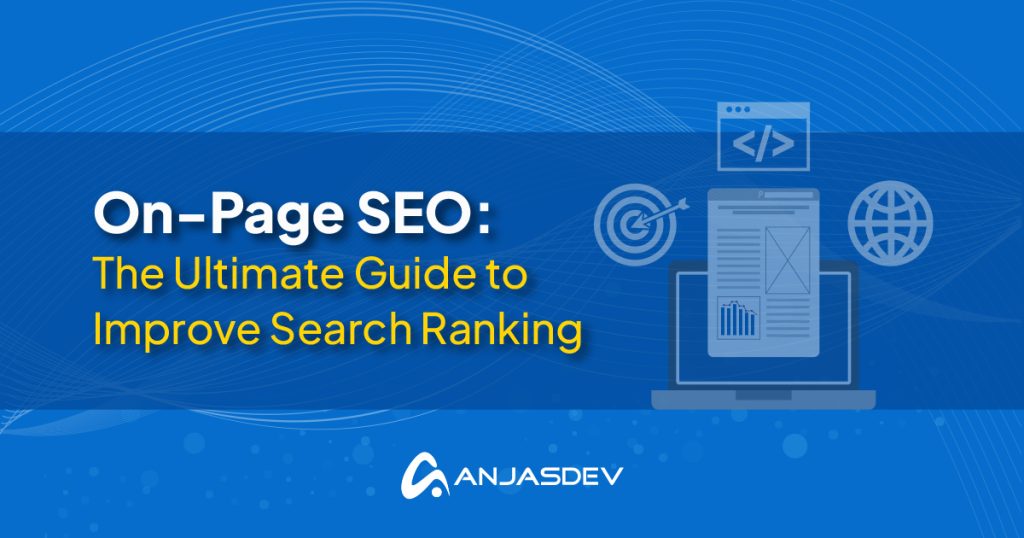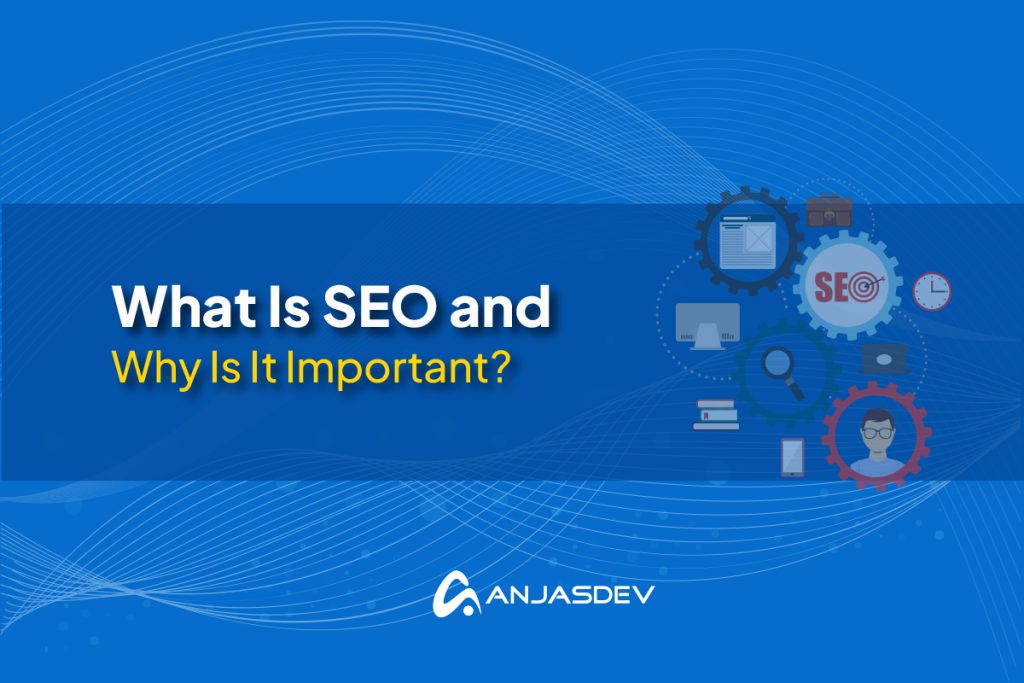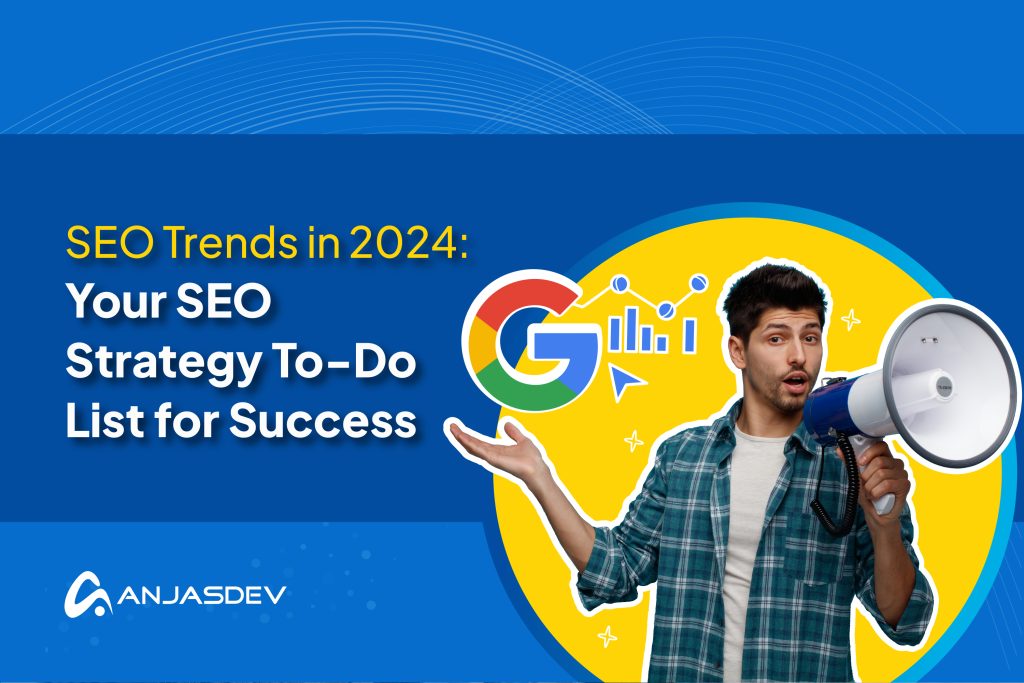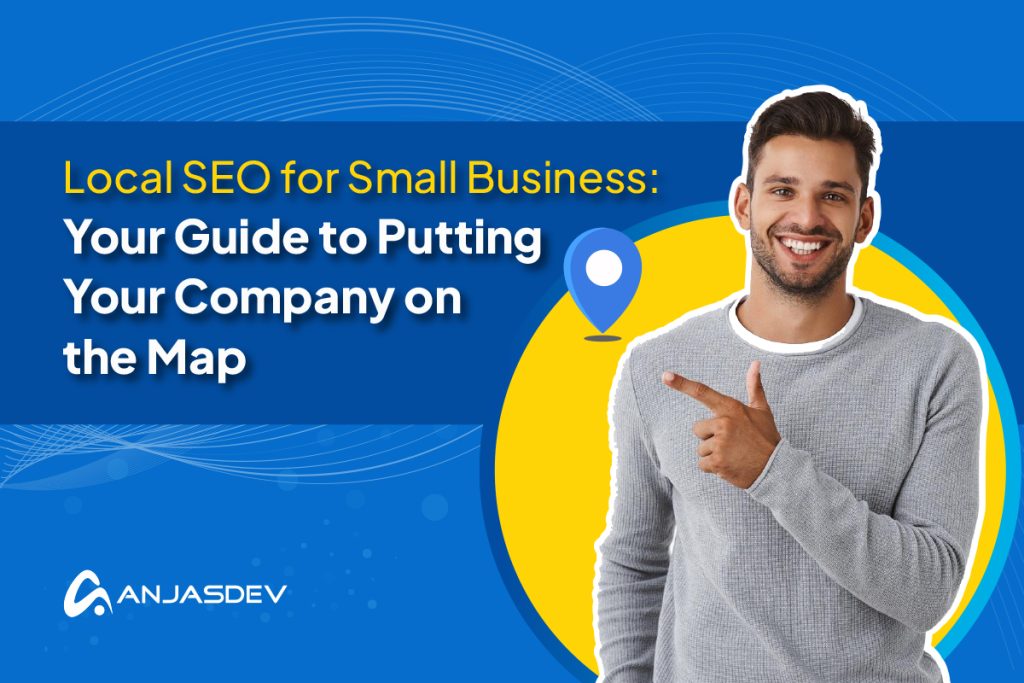
If you’re looking to increase your business’s visibility, on-page SEO optimization is the practical way to boost organic traffic to your pages. By strategically creating your web pages and providing value to users, from increasing relevance through keywords to enhancing user experience with seamless page loading and authoritative content, you not only enhance your website’s reputation with users but also with search engines like Google.
Rest assured, we’ll guide you through everything you need to know about on-page SEO and how to use it effectively. By the end, you’ll feel confident in your ability to improve your website’s visibility and user experience.
What is On-page SEO?
On-page SEO is optimizing individual web pages for optimum ranking on search engine results pages (SERPs). It comprises a multitude of strategies, including keyword implementation and optimizing user experience through increasing relevancy to user intent and technical considerations like navigation and page load times.
On-page SEO optimization has two main targets: search engines and the users themselves.
Creating technically sound webpages with clearly defined components, including informative headings, image captions, and relevant keywords, facilitates search engines’ indexing of them properly for display on SERPs. The more details put into this, the richer the search result displayed and the more likely it is to appeal to users.
Speaking of users, by creating content that meets their search needs and user intent, you increase click-through rates and user experience, building trustworthiness in your business. This has a dual effect, not only increasing user conversions and opinions of your site but also showing search engines that users hold that page in high esteem, earning it higher SERP placement.
Keep on reading to learn all the components of on-page SEO and how they fit into this framework of increasing user and search engine relevance.
On-page SEO vs. Off-page SEO
Aside from the clear difference in their names, one key way to distinguish between on-page and off-page SEO is to look at their overall goals as strategies.
On-page SEO focuses primarily on increasing relevance through optimizing factors on the web pages themselves, such as increasing user experience and adding relevant keywords to increase visibility and ranking on search engines like Google.
Off-page SEO’s primary goal is to build a website’s credibility and trust by performing various tasks, such as generating backlinks, social media marketing, and increasing brand mentions.
So, on-page SEO aims to improve the performance of individual pages on SERPs (search engine results pages), while off-page SEO aims to increase the status and ranking of the entire website or brand.
Why is On-Page SEO Optimization Important?
On-page SEO optimization is important to get right as it is the primary way in which search engines determine whether a webpage is relevant to a user’s search query. If the page is deemed useful by the search engine and meets the user’s intent and requirements, it will rank higher in the SERPs.
However, on-page SEO is about more than just stuffing as many keywords in as possible and as much as possible in the hope that it is picked up by the algorithm. A lot of search engines, such as Google, prioritize “people first content”. What this means is that it looks for content that is helpful for human users rather than that which is tailored towards the search engine and its algorithms.
By using a well-rounded approach to on-page SEO, you will benefit from increased organic traffic, which in turn can help boost your website’s credibility and trustworthiness further by creating greater user engagement on your pages and lower bounce-back rates. Search engines rate these things highly when assessing what they display in their SERPs.
In addition, optimizing linking structure, navigation, descriptions, and loading times will help search engine crawler bots index your site effectively, which is crucial. A survey carried out by Onely found that around 16% of valuable pages on well-known websites need to be indexed, highlighting the importance of robust on-page SEO efforts, especially regarding content that is critical to your business’s success.
What Matters for On-page SEO?
On-page SEO is all about 2 things: page structure and meeting user intent.
The page’s structure, including the layout of text, image quality and captions, URLs, and internal navigation to other key areas of the site, helps to improve user experience and facilitate search engine indexing.
Creating relevant, informative, and engaging content targeted to users’ needs improves search ranking and how your site performs next to criteria such as Google’s E-E-A-T principles.
Types of User Intent
There are 4 main types of user intent, and most online searches will fall into at least one of these categories to be successful. They are:
- Navigational Intent: In this case, the user is trying to navigate to a specific website or online destination. For example, searches like “Facebook” or “Amazon” indicate that the user wants to visit those websites directly.
- Informational Intent: Users with informational intent are seeking information or answers to their questions. Searches like “What is the capital of France?” or “How to bake a cake” fall into this category. The user is looking for factual information, instructions, or explanations. Informational queries don’t always have to be questions, though, as a search like “coffee cake recipe” would also be considered informational.
- Transactional Intent: This type of intent involves users who are ready to make a purchase or complete a transaction. Searches like “buy running shoes online” or “book a flight to New York” indicate transactional intent. Users are looking to purchase a product or service.
- Commercial Intent: In this case, users are researching or comparing products or services before making a purchase decision. Searches like “best laptop for students” or “reviews of iPad Pro” suggest that the user is in the research or consideration phase of the buying process. In some cases, this also may overlap with informational intent in the early stages of the purchasing process.
Structural Features
Below, we’ve listed some of the key ways that the page’s structure and format are optimized during on-page SEO.
- Title Tags: The title tag is one of the most critical on-page elements for SEO. It should accurately describe the page’s content and include relevant keywords to help it be indexed.
- Meta Descriptions: Meta descriptions provide a brief summary of the page’s content and are often displayed in search results. Well-crafted meta descriptions can improve click-through rates. It’s important to ensure that the length is not too short that it is uninformative or too long that it gets cut off in the search results. Standard practice is to meet a limit of 160 characters.
- Header Tags (H1, H2, H3): Header tags help structure the content and hierarchy of a page. Using relevant keywords in header tags can signal relevance to search engines. Breaking up content using headers also increases readability for the user, creating sections with subheaders that are easier to digest or allowing them to find the heading that best meets their current needs.
- Keyword Placement and Density: Strategic placement and appropriate density of relevant keywords within the content can help search engines understand the page’s topic and relevance.
- Image Optimization: Optimizing images with descriptive file names, alt text, and proper formatting can improve user experience and provide additional relevance signals to search engines. In addition, optimizing file sizes without impacting image quality will help increase page load times.
- Internal Linking: Linking to other relevant pages within your website can help search engines better understand the site’s structure and content relationships. It can also provide the user with further reading on related topics, helping to expand the browsing session of those with informational or commercial intent.
- URL Structure: Descriptive and keyword-rich URLs can provide relevance signals and improve user experience.
- Page Load Speed: Faster page load times can enhance user experience and are considered a ranking factor by search engines. Research has shown that for each second saved on loading time, conversion rates go up by 17%.
- Mobile-Friendliness: With the increasing use of mobile devices and with 60% of all browsing sessions starting on one, having a mobile-friendly website is crucial for both users and search engine rankings.
How Do You Implement On-page SEO?
Now that you understand a bit more about on-page SEO, it’s time to put it into practice. We’ll walk you through some key ways to start optimizing your web pages for success, helping them maintain a robust relevance and presence through multiple core algorithm updates.
Research and Implement Keywords
Keywords are one of the most important things that search engines take into consideration when looking at whether your website is relevant to a user’s search query. So, you need to make sure you know which ones are the best fit for your pages.
To do this, you need to start by undertaking keyword research. This can be done by:
- Finding out what wording successful competitors are using,
- Use a keyword research tool like Ahrefs, SEMRush, or the Google Search Console.
Keyword research tools are one of the best ways to do this, as they not only provide you with related keywords but a wealth of information, too. They will let you know what type of user intent matches the keyword, as well as the amount of traffic that these keywords typically generate and a slew of other metrics besides.
When it comes to actually using your keywords on your page, you may be tempted to cram them everywhere. But this can actually be harmful to your SEO efforts, which we’ll cover a bit later.
Instead, aim for a rule of 10. This means that your main keywords (usually 2 or 3 maximum) should be used around 10 times on the page. Additional keywords can be used less frequently, for example, 2 to 3 times.
In addition, try to use your main keyword in your page URL, as well as in your main headings and title where appropriate to do so.
When adding keywords to page content, the goal is to make things as natural as possible. If your keyword stands out like a sore thumb when a user is reading your text, it can be off-putting.
Segment Content with Headings
Headers not only help Google to segment your content and find relevant snippets to display to users, but they also improve the content’s readability.
Try to break your content up into clearly defined sections with headings. The general rule is that you should only use <H1> once at the start of the content, and all other headings should be in the <H2> format. If any <H2> sections are quite long, breaking them up further with <H3> subheadings will help your users to be able to navigate through the text much more easily.
Make an Engaging Meta Description
The meta description is what shows up on your search results on Google and other search engines underneath the page title. It looks a bit like this:

If a meta description exceeds 160 characters, Google and most other search engines will cut it off. So, you want to make sure you are making your point as quickly and efficiently as possible.
Great meta descriptions also try to address the user with a call to action (CTA). This could be in the form of action verbs, like “explore” or “discover”, or direct address “you”. Adding your keyword to the meta description will also make it come up bold in Google search results, like in our first example, which helps to highlight its relevance to the user and make the page more likely to receive higher click-through rates.
Create an Engaging Title and Page URL
Your web page’s title is one of the first things that a user sees when it pops up in their SERP. So, making sure it is engaging and compelling is essential to garner that all-important traffic.
Keep your webpage title to around 70 characters. Otherwise, it will be truncated like the meta descriptions.

Try to include the main keyword in the title to increase relevance, but also think about ways you can make your title stand out from the crowd. Try to phrase the tone of the title to match user intent. For example, an informational page title could be “How to Travel on a Budget: Your Questions Answered.”
Other techniques that can work well include humor and adding freshness, like we’ve done in our blog post: PPC Trends in 2024: Top 11 Tips to Follow This Year, which helps users to know your information is up-to-date and likely more relevant to their needs.
When it comes to your page’s URL, the aim is to keep it short and sweet but still relevant. A good rule of thumb is to have your main keyword as the URL slug—that’s the bit of the URL that defines that particular page. For example, if your keyword is “things to do in France”, then the URL for that page could be site.com/articles/things-to-do-in-france.
Add Internal Links
When creating content for your website or updating pages, always consider how they can connect to other pages on your site. Adding relevant internal links can increase the navigational experience for users, helping them get to what they need and increasing their engagement with your site. In addition, they help search engine crawler bots understand more about what the page is about and what pages are of the highest importance on your site, thanks to how many times they have been linked.
When you add internal links, like keywords, they should be added in a way that seems natural so that the text on the page still flows for the user. Try to stay moderate with them, too, as this can also lead to a distracting experience. For example, you could add an in-text link to other blog posts like we have just done, or, it can be added as a footnote at the end of a section like this:
Add External Links
In much the same way, implementing external links to relevant, authoritative sources can improve on-page SEO. It demonstrates your content’s credibility and trustworthiness to search engines and helps to demonstrate the thought and research you have put behind your content.
Linking to high-quality websites also helps search engine crawlers better understand your page’s context and relevance, potentially boosting rankings for targeted keywords.
Put E-E-A-T at the Heart of Your Content
Although it’s great to ensure balanced meals every day, we mean something else when it comes to on-page SEO! E-E-A-T stands for Experience, Expertise, Authority, and Trust. Google uses this to rate pages in its Quality Search Rater Guidelines, which form the benchmark for how sites perform in search rankings and how it determines whether they are trusted sources on the web.
The parts of E-E-A-T that you can hit really well with on-page SEO are the two Es – Experience and Expertise. Aim to create content that shows that you really know your stuff, with detailed research, both your own and from other sources if applicable. Highlight the experience of the contributors creating content for your site, especially if they are relevant to your industry, in their author bios. Create your own original content that shows your expertise, such as how-to-videos or a photographed step-by-step guide.
Advanced On-page SEO Practices
We’ve covered some of the simpler ways to implement on-page SEO. Now, we’ll take you through some of the more advanced aspects, including elements of technical SEO that can help boost the search rating of your pages.
Compress Images to Reduce Loading Time
No one wants to visit a site that takes an eternity to load. One of the main reasons behind sluggish sites is that videos, images, and other media need to be bigger in file size. This means the browser takes a longer time to load them and can be a real data sapper for those on mobile devices. Taking the time to compress images and other media to smaller file sizes can boost your webpage’s performance. While you are there, giving them logical file names and relevant alt text will also help with crawlability.
Boost Loading Times and Make Pages Mobile-Friendly
Google’s Page Experience Signals take into account how smoothly your site loads and runs on all devices. The key things you’ll want to look out for and optimize are:
First Input Delay (FID): The time it takes for a web page to respond to the first user interaction, such as a click or tap. A lower FID value indicates better responsiveness.
Largest Contentful Paint (LCP): The time it takes for the largest content element on a web page to become visible and render. This metric helps measure perceived load speed and is great to run if you’re trying to optimize images and other media.
Cumulative Layout Shift (CLS): The sum of all individual layout shift scores for every unexpected layout shift that occurs during the entire lifespan of a web page. Lower CLS values indicate better visual stability, while a site with high CLS values will be jumping about all over the page.
Complete Schema Markup
Have you ever wondered how some pages manage to pull and display rich amounts of information on the SERP? For example, how do some of them manage to get an image next to their listing or feature product reviews? The answer is schema markup. When schema code is implemented, search engines better understand and display your content in rich snippets or enhanced search results.
These insights can also impact other factors of the search experience, including making it much more likely for your content to be considered part of Google’s SGE (search generative experience), which uses AI to create an answer to users’ queries by compiling information from various online sources.
How Much Does On-page SEO Cost?
The real answer to this question is: it depends. Although this may seem vague, digital marketing agencies have a lot to consider before they can offer you a price. For example, the size of the website and the amount of optimization needed are important factors in determining the cost.
As a ballpark, smaller websites and companies typically spend a few hundred dollars a month on SEO services. Meanwhile, larger enterprises and businesses with multiple domains are more likely to have a monthly SEO bill in the tens of thousands instead.
By talking with a trusted SEO agency like AnjasDev, you can ensure that you get a custom quote and strategy that perfectly fits your needs. You’re paying for exactly what you need, no more and no less.
How Do You Analyze On-page SEO and Evaluate the Results?
Once you have carried out your implementation of on-page SEO, you’ll want to know how your pages are now performing. The best way to do this is to use an SEO analytics tool, such as those offered by SEMRush, SE Ranking, and SEOptimizer. SEO tools like these will run in-depth checks on your website for core metrics that search engines look for, and then provide you with a report letting you know how your website and its pages stack up. Usually, they will also give you recommendations and highlight problem areas for you to target to make quick fixes that have a real impact.
How to Improve On-page SEO?
If you have found out that your on-page SEO needs work – don’t worry! If you have been using an SEO tool, this will likely tell you what you need to fix. If not, try going through our implementation steps listed further in this guide to find areas that you can work on.
But, if you are looking for some quick fixes in the meantime, here are the best things you can do for a big impact with minimal input:
- Fix broken links and add internal links where appropriate.
- Review and edit your webpage titles for relevancy.
- Check the density of your main keywords and add more if needed.
- Make sure all pages are utilizing appropriately titled and structured headings.
- Look for clunky URLs and optimize them for clarity and crawlability.
Get Professional On-page SEO Services from AnjasDev
Of course, there is one surefire way to ensure you are on top of your on-page SEO game. Working with a digital marketing agency with proven expertise in on-page SEO can start moving your website in the right direction.
AnjasDev has been working with businesses for over 10 years, providing tailored services that have delivered results time and time again. Schedule a conversation with us about your on-page SEO needs, and we’ll work with you to create a data-driven strategy that will propel your business’s visibility and growth in the online market.



